Do you have a question about the GRAUPNER Twister and is the answer not in the manual?
Detailed specifications including wingspan, fuselage length, wing area, and all-up weight.
Crucial advice for safe and proper assembly, including checking components and radio systems.
Guidance on correcting creases or warping in the covering sheet using heat.
Lists motors, drive batteries, speed controllers, propellers, radio control systems, and adhesives.
Lists fuel, filters, hoses, pumps, spark plug batteries, and starters for ICE operation.
Lists essential tools such as screwdrivers, pliers, knives, drills, and soldering iron.
Instructions for beginning the assembly process and preparing the wing halves, including servo mounting.
Procedure for pulling servo cables into wing halves and securing servo mounts.
Steps for preparing and gluing control horns to wing surfaces for adequate connection.
Instructions for attaching the landing gear to the wings using hinges and ensuring proper alignment.
Preparing rudder, elevator, and landing flap linkages and adjusting them for neutral servo position.
Installing servos for retractable undercarriage and adjusting steering linkages for locking.
Attaching wheels to axles and securing them with grub screws and thread-lock fluid.
Transferring drill hole positions for propulsion systems onto the fuselage bulkhead using a template.
Mounting the engine to support arms and preparing throttle linkage on the bulkhead.
Assembling and installing the fuel tank with correct tube routing, sealing, and securing in the fuselage.
Connecting fuel tank lines to carburetor and silencer, and routing fuel line for fueling and pressure.
Cutting openings in the engine bonnet and attaching it to the fuselage, ensuring a perfect fit with the spinner.
Mounting the electric motor, connecting cables, and checking rotation direction.
Gluing the tailplane and vertical stabilizer precisely to the fuselage, ensuring correct alignment.
Separating parts using heat, securing horizontal stabilizer, and inserting linkages for tail control surfaces.
Fitting and fastening the fuselage cover to the opening using adhesive film and spring-loaded locking mechanisms.
Attaching tailwheel wire, mounting elevator/rudder/throttle servos, and pre-drilling pilot holes for screws.
Inserting and fastening the drive battery in the electric version into the fuselage using a mounting board.
Gluing the pilot figure and attaching the cockpit canopy to the fuselage using transparent adhesive film.
Fastening the receiver to the RC board and orienting aerials at a 90° angle for optimal signal reception.
Installing the ON/OFF switch for the RC system on the fuselage side wall, melting openings for switches.
Connecting control surface servos with extension cables and attaching wing halves to the fuselage using latches.
Procedure for checking and adjusting the center of gravity for optimal flight stability in inverted position.
Recommended rudder deflections for ailerons, elevators, rudder, and landing flaps for initial setup.
Essential safety tips for motorized aircraft models, including age restrictions, adult supervision, and responsible operation.
Guidelines for ensuring radio control system reliability, checking frequency, and avoiding interference.
Warnings about the danger of propellers and rotating parts, and the necessity of keeping clear of them.
Precautions regarding operating outdoors, model fuel toxicity, flammability, and storage.
Warnings about motor heat, exhaust fumes, and the need for protective gear like gloves and ear protection.
Importance of checking for damage, noise considerations, protective eyewear, and avoiding entanglement with rotating parts.
Guidelines for safe engine stopping, public safety, keeping aircraft in sight, and adhering to regulations.
Liability disclaimer and emphasis on careful and responsible operation of the model, and awareness of legal requirements.
Details on warranty coverage, claims process, and conditions that void the guarantee due to improper handling.
Essential checks for radio system, batteries, channel availability, and servo freedom before each flight.
Instructions for cleaning the model and RC components after use and re-lubricating moving parts for longevity.
Advice on studying instructions, using suitable cables, and preparing surfaces for gluing and painting for proper adhesion.
Detailed specifications including wingspan, fuselage length, wing area, and all-up weight.
Crucial advice for safe and proper assembly, including checking components and radio systems.
Guidance on correcting creases or warping in the covering sheet using heat.
Lists motors, drive batteries, speed controllers, propellers, radio control systems, and adhesives.
Lists fuel, filters, hoses, pumps, spark plug batteries, and starters for ICE operation.
Lists essential tools such as screwdrivers, pliers, knives, drills, and soldering iron.
Instructions for beginning the assembly process and preparing the wing halves, including servo mounting.
Procedure for pulling servo cables into wing halves and securing servo mounts.
Steps for preparing and gluing control horns to wing surfaces for adequate connection.
Instructions for attaching the landing gear to the wings using hinges and ensuring proper alignment.
Preparing rudder, elevator, and landing flap linkages and adjusting them for neutral servo position.
Installing servos for retractable undercarriage and adjusting steering linkages for locking.
Attaching wheels to axles and securing them with grub screws and thread-lock fluid.
Transferring drill hole positions for propulsion systems onto the fuselage bulkhead using a template.
Mounting the engine to support arms and preparing throttle linkage on the bulkhead.
Assembling and installing the fuel tank with correct tube routing, sealing, and securing in the fuselage.
Connecting fuel tank lines to carburetor and silencer, and routing fuel line for fueling and pressure.
Cutting openings in the engine bonnet and attaching it to the fuselage, ensuring a perfect fit with the spinner.
Mounting the electric motor, connecting cables, and checking rotation direction.
Gluing the tailplane and vertical stabilizer precisely to the fuselage, ensuring correct alignment.
Separating parts using heat, securing horizontal stabilizer, and inserting linkages for tail control surfaces.
Fitting and fastening the fuselage cover to the opening using adhesive film and spring-loaded locking mechanisms.
Attaching tailwheel wire, mounting elevator/rudder/throttle servos, and pre-drilling pilot holes for screws.
Inserting and fastening the drive battery in the electric version into the fuselage using a mounting board.
Gluing the pilot figure and attaching the cockpit canopy to the fuselage using transparent adhesive film.
Fastening the receiver to the RC board and orienting aerials at a 90° angle for optimal signal reception.
Installing the ON/OFF switch for the RC system on the fuselage side wall, melting openings for switches.
Connecting control surface servos with extension cables and attaching wing halves to the fuselage using latches.
Procedure for checking and adjusting the center of gravity for optimal flight stability in inverted position.
Recommended rudder deflections for ailerons, elevators, rudder, and landing flaps for initial setup.
Essential safety tips for motorized aircraft models, including age restrictions, adult supervision, and responsible operation.
Guidelines for ensuring radio control system reliability, checking frequency, and avoiding interference.
Warnings about the danger of propellers and rotating parts, and the necessity of keeping clear of them.
Precautions regarding operating outdoors, model fuel toxicity, flammability, and storage.
Warnings about motor heat, exhaust fumes, and the need for protective gear like gloves and ear protection.
Importance of checking for damage, noise considerations, protective eyewear, and avoiding entanglement with rotating parts.
Guidelines for safe engine stopping, public safety, keeping aircraft in sight, and adhering to regulations.
Liability disclaimer and emphasis on careful and responsible operation of the model, and awareness of legal requirements.
Details on warranty coverage, claims process, and conditions that void the guarantee due to improper handling.
Essential checks for radio system, batteries, channel availability, and servo freedom before each flight.
Instructions for cleaning the model and RC components after use and re-lubricating moving parts for longevity.
Advice on studying instructions, using suitable cables, and preparing surfaces for gluing and painting for proper adhesion.
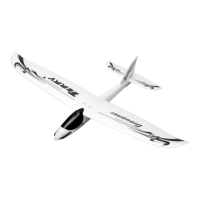
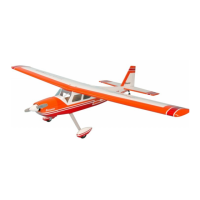
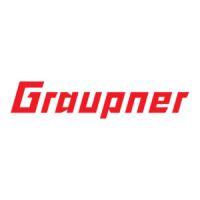

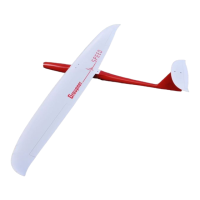
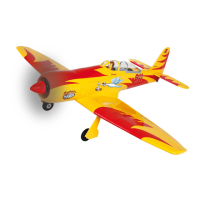


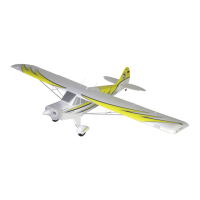
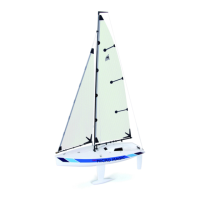
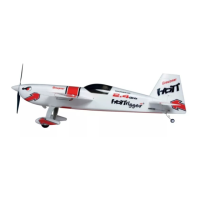
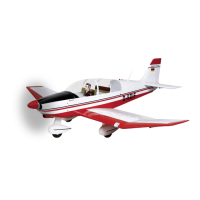
